Overview
The Shift
GLP-1 therapies have rapidly evolved from specialized diabetes drugs to a global cultural and economic force. Once confined to endocrinology, they now shape everyday conversations on weight management, lifestyle change, and even shifting ideals of health and beauty. Their influence extends beyond the clinic into mainstream media, consumer culture, and public debate.
Polarized Discourse
Our AI-driven analysis of social platforms (TikTok, Reddit, X/Twitter, forums) and global search signals (2021–2025) reveals a strikingly divided narrative. Roughly four in ten conversations (39.4%) highlight optimism and excitement - celebrating transformative weight loss outcomes, improved metabolic health, and renewed energy. Almost as many (37.2%) voice concerns: drug shortages, affordability challenges, side-effects like nausea and fatigue, and ethical debates over off-label or cosmetic use. The remainder (23.4%) reflects a neutral, informational layer - trial updates, dosing questions, and factual reporting that anchor public understanding.

Analysis showcases UGC (User Generated Content) across 4 web sources (X, Reddit, YouTube & Google) covering content on GLP-1 as a subject & category, associated aspects, leading products and innovative approaches within the GLP-1 space.
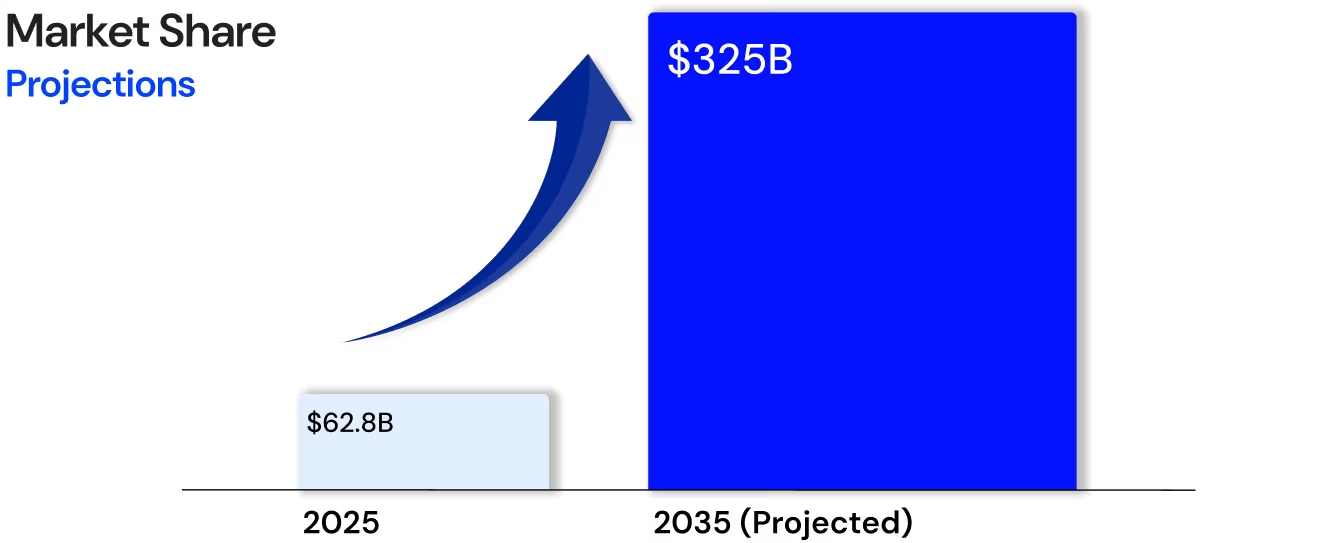
This near-equal split shows that GLP-1 adoption is driven not only by clinical data but also by public perception, digital narratives, and lived experiences. In 2025, the GLP-1 market already exceeds $62.8 billion, with projections as high as $325 billion by 2035. Yet cultural excitement and consumer anxiety remain tightly interwoven. How stakeholders respond- addressing cost, safety, and expectation management- will determine whether GLP-1s remain a breakthrough therapy for the few or expand into a foundation of preventive medicine for the many.
Explosive Market Growth
The GLP-1 receptor agonist market has entered an unprecedented growth phase. In 2025, global revenues are estimated at $62.8 billion, up from $53.5 billion in 2024. Projections indicate expansion to between $150 billion and $325 billion by 2035, powered by broader therapeutic indications, new formulations, and wider insurance coverage.
Regional Leadership
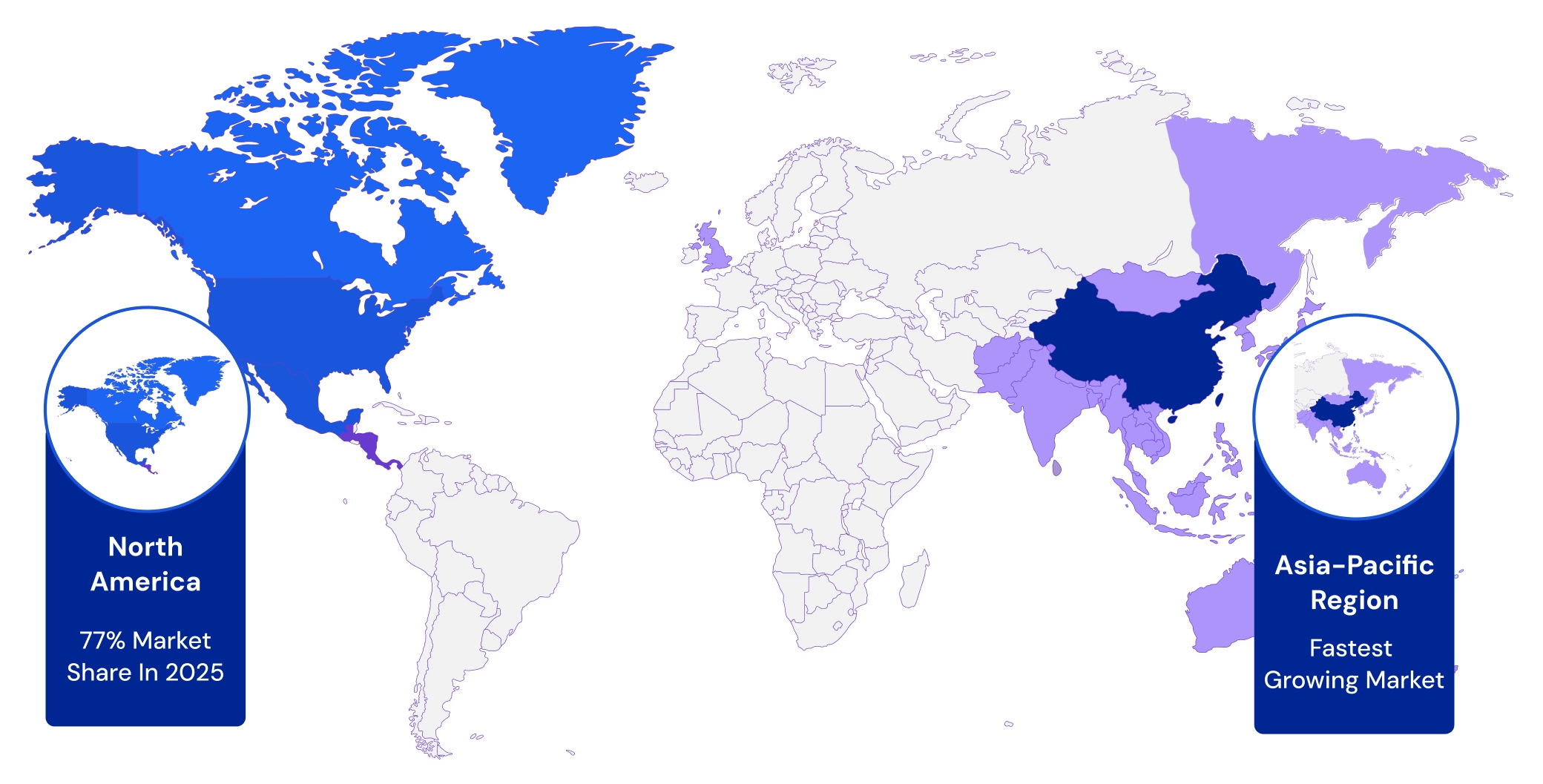
North America dominates with an estimated 77% share of global revenues in 2025, reflecting high adoption, payer support, and robust R&D investment. The Asia-Pacific region is the fastest-growing market, driven by surging obesity and diabetes rates, improved healthcare infrastructure, and accelerating regulatory approvals. Europe contributes steadily through EMA approvals, but disparities across geographies remain stark, with low and middle-income markets showing limited access and awareness.
Prescription Trends
- In the United States, GLP-1 prescriptions for obesity climbed 587% between 2019 and 2024 as adult obesity prescribing increased nearly 20-fold in the same period.
- This surge is driven by new clinical efficacy data, celebrity and social media influence (notably TikTok and direct-to-consumer health platforms), increased awareness of obesity as a treatable chronic disease, and broadening guidelines from medical societies.
- By 2024, GLP-1s accounted for 10.5% of all annual pharmacy claims in the US.
- Demand has outpaced supply nationally, leading to shortages, expanded use of compounding pharmacies, and changing patterns in obesity-management clinic visits.
Innovation & Expansion
- Globally, over 300 GLP-1-based formulations are in active clinical development, ranging from oral tablets (like orforglipron) to dual- and triple-agonist therapies aimed at improving efficacy and reducing side effects.
- Innovation is particularly intense around oral GLP-1s, which offer easier administration and have prompted major pharmaceutical investment, alongside injectable and patch-based delivery mechanisms under investigation for regulatory approval.
- Combination treatments targeting obesity, diabetes, cardiovascular disease, NASH, renal, hepatic, and sleep disorders are progressing through clinical trials, reflecting mainstream acceptance of GLP-1s as multi-platform therapies.
- Pipeline drugs aim to overcome current side effect profiles, provide longer-lasting effects, and include consumer-friendly features- anticipated to further accelerate adoption through 2028.
Challenges
- Affordability and equity issues remain formidable: surveys show 64% of potential patients cite cost as a major obstacle, with pricing averaging $1,000 per month and insurance coverage often restrictive due to prior authorization or step therapy requirements.
- Insurers express growing concern as GLP-1s now comprise over one-tenth of annual pharmacy claims, prompting payer restrictions and heightened scrutiny of overall costs and coverage expansion.
- Persistent supply-demand imbalances, patchy Medicaid/private insurance coverage, and price inequities across regions reinforce access gaps- especially among marginalized and lower-income populations.
- Without substantial policy reforms, pricing innovation, and coverage expansion, projected growth will likely further increase access disparities and frustrate population health goals.
Public discourse around GLP-1 therapies has been dynamic, marked by alternating waves of optimism, turbulence, and cautious stabilization. From early breakthroughs to mainstream cultural virality, the conversation illustrates how scientific milestones and media narratives can rapidly reshape sentiment.
Public perception is nearly as influential as clinical trial outcomes in shaping adoption, regulatory focus, and cultural acceptance.
Most Frequent Words
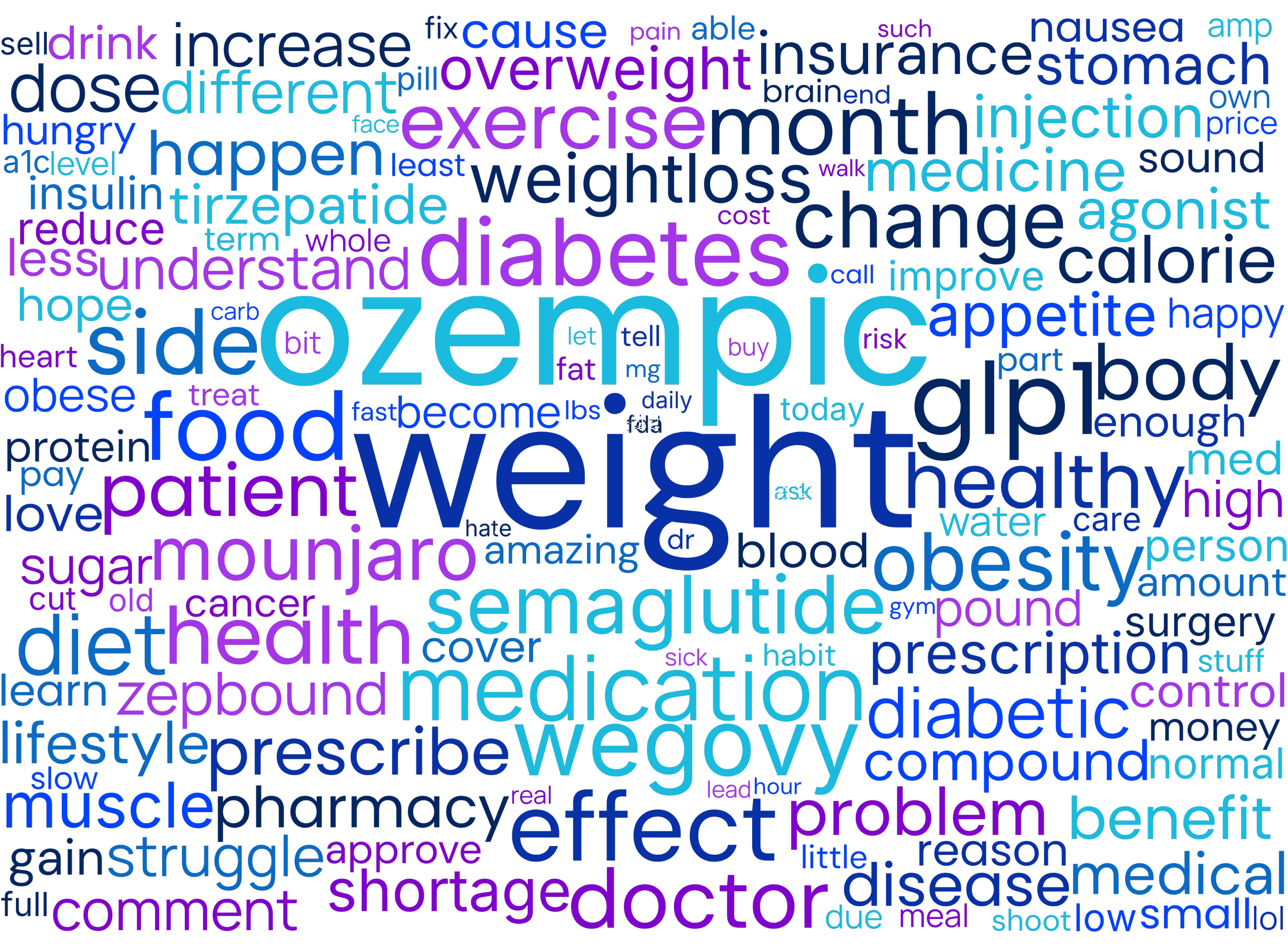
- Weight management and metabolic health dominate public discourse, as evidenced by the frequency of terms like "weight," "weightloss," "obesity," "diet," "exercise," and "calorie." This underscores the centrality of GLP-1 drugs in conversations about not just diabetes control, but holistic body health, lifestyle changes, and personal transformation. The word cloud confirms GLP-1s are widely associated with broader wellness goals, not limited to disease management.
- Brand awareness and product comparisons are highly prevalent, with drug names such as "ozempic," "wegovy," "mounjaro," "zepbound," "semaglutide," and "tirzepatide" appearing prominently. This signals intense consumer and patient interest in differentiating drug types, understanding new therapies, and evaluating efficacy, safety, and accessibility. It also highlights ongoing competition and the importance of pharmaceutical branding.
- Barriers and challenges to access stand out, with frequent mentions of "prescription," "insurance," "pharmacy," "price," "shortage," and "compound." These words point to complex real-world issues around cost, supply availability, entry to treatment (prescription requirements), and evolving solutions like compounding, all major themes driving market dynamics and patient frustration.
- Medical and clinical concerns remain top-of-mind, illustrated by recurring terms such as "side effect," "problem," "risk," "benefit," "stomach," and "nausea." These words reveal that while excitement about benefits runs high, conversations are equally focused on adverse events and real-world patient experiences, reinforcing the need for robust education and support.
- Engagement with healthcare professionals and health literacy is substantial, seen in frequent references to "doctor," "patient," "control," "diabetic," "medicine," and "understand." This stresses the ongoing dialogue between patients and practitioners and the role of informed choice, medical oversight, and education in safe, effective GLP-1 adoption.
The rise of GLP-1s is not only a clinical story - it is a cultural phenomenon amplified by digital ecosystems. Traditional drug adoption curves were driven by physician detailing and clinical guidelines. In contrast, GLP-1 awareness has been shaped by this loop.
This loop has dramatically accelerated demand, sometimes outpacing prescriber guidance and regulatory readiness. It also shows how modern therapies can be propelled into the spotlight by cultural catalysts as much as by scientific milestones.
- The sustained and growing volume of global monthly searches across all six GLP-1 drugs reflects a heightened and expanding consumer curiosity and engagement worldwide. This trend indicates that GLP-1 therapies have moved beyond specialist circles into mainstream awareness, driven by increasing public discourse around obesity and diabetes management. The steady climb from around 900,000 searches weekly in early 2023 to peaks exceeding 2 million by mid-2025 underscores how demand for information mirrors heightened product adoption, regulatory approvals, and media coverage at a global scale.
- The clear seasonal fluctuations observed in search patterns, with consistent peaks during spring (March-April) and fall (October-November), likely correspond to periods when consumers become more focused on health-related behavior changes, such as post-winter resolutions or pre-holiday weight management efforts. Coupled with social media trends and major marketing campaigns released cyclically, these seasonal spikes reveal important windows for targeted educational outreach and promotional activities to optimize patient awareness and engagement aligned to consumer health cycles.
- The recent average search volume plateauing above 2 million monthly searches in 2025 signals a maturing but highly active market landscape where interest remains intense but competitive. This persistence in high search activity demonstrates robust market health and suggests sustained opportunities for pharmaceutical innovation, telehealth expansion, and digital marketing refinement. For stakeholders, continuing to analyze such search trends can uncover emerging consumer concerns, variations in drug preference, and regional access issues critical for strategic decision-making and patient-centric educational programming in the GLP-1 domain.
- Ozempic maintains dominant consumer interest across the timeline, consistently showing the highest weekly search volumes. Its search popularity peaks above 1,060,000, reflecting sustained market leadership and strong consumer engagement driven by broad brand recognition and perceived efficacy.
- Wegovy and Mounjaro show significant growth trajectories, with peak weekly searches crossing 400,000 and 630,000 respectively by early to mid-2025. These trends demonstrate their rising market presence and increasing consumer curiosity, positioning them as strong contenders challenging Ozempic’s dominance in the GLP-1 space.
- Emerging competitors like Zepbound have carved a smaller but steady niche, peaking around 190,000 weekly searches and showing gradual adoption. Meanwhile, Rybelsus and Semaglutide Injection register lower search volumes indicative of niche or specialized use cases, but their consistent search presence highlights an established patient base and ongoing relevance within the category.
- Increasing Interest in GLP-1 Products on Social Media
The GLP-1 Products category shows a steady upward trend over the period, starting around 47 in January 2023 and reaching a peak near 83 by November 2024. This signals growing public and expert engagement with specific GLP-1 drugs on Twitter, reflecting heightened consumer awareness, discussion about new launches, and ongoing real-world experiences shared around these therapies. - Fluctuating but Overall Rising Research & Development Conversations
Research and Development (R&D) discussions show some month-to-month variability but maintain a solid upward momentum overall, increasing from about 40 in early 2023 to above 68 by mid-2025. This reflects sustained industry and academic focus on innovation, clinical trials, and new indications for GLP-1 drugs, underscoring active pipeline advancements and emerging therapeutic applications. - Moderate but Increasing Focus on Pharmaceutical Innovation
Conversations related to Pharmaceutical Innovation began strong in the 50–70 range and experienced fluctuations yet trending upward towards 68 by mid-2025. This indicates increasing attention on manufacturing breakthroughs, novel delivery pathways, and next-generation product formulations that promise improved efficacy, safety, and patient convenience within the GLP-1 marketplace.
- Dominant Focus on Weight Loss Medications and Fluctuating Interest in Diabetes Management
Throughout the period, "Weight Loss Medications" consistently hold the highest relative interest among the three application topics, starting above 54% and maintaining generally strong engagement around 50-70%. In contrast, "Diabetes Management" exhibits a downward trend from peak engagement near 83% in early 2023 to lower 30-50% levels by mid-2024, indicating a gradual shift of social media conversations towards obesity and weight loss as primary focal points within the GLP-1 discourse. - Significant Spikes in Health Risks Discussions with Increasing Frequency
The "Health Risks" category shows notable variability but a marked increase in interest starting mid-2023, with peaks near 50% or higher, especially in July-August 2023 and again in early 2025. This rise likely reflects growing public and professional attention to adverse effects, safety concerns, and controversy surrounding GLP-1 drug use, highlighting the importance of addressing real-world clinical risks in ongoing education and communication efforts. - Social Media Conversations Reflect a Dynamic and Evolving Narrative Around GLP-1 Applications
The interplay between the three application topics- weight loss, diabetes management, and health risks- reveals a complex, evolving landscape on social platforms. While weight loss dominates as the most discussed application, heightened health risk awareness periodically gains traction, and diabetes remains a foundational but relatively less emphasized theme over time, illustrating how user focus shifts in response to emerging data, marketing, and societal concerns on digital discourse platforms like Twitter.
Conclusion
This report delivers a comprehensive synthesis of hundreds of thousands of user-generated posts, comments, and discussions from four leading digital platforms, spanning a multi-year horizon of the GLP-1 drug landscape. By integrating quantitative search trends, evolving sentiment patterns, and platform-specific behavioral insights, the analysis illuminates not only what drives public interest, but how market leaders are shaped and scrutinized in real time.
Through the detailed examination of digital attention, emerging innovation, product-specific dynamics, and evolving public discourse, these findings offer an authentic, data-driven perspective on how the GLP-1 category is experienced by patients, healthcare professionals, and the wider public. The collective narrative underscored here demonstrates that the GLP-1 therapeutic space is both highly dynamic and polarized, shaped by waves of endorsement, criticism, breakthrough announcements, and ongoing patient and provider feedback.
As the GLP-1 segment continues to expand- with digital touchpoints playing an ever-larger role in awareness, demand, and reputation, these insights equip stakeholders across pharma, healthcare, and policy to better anticipate trends, address concerns, and inform evidence-based decision making in this rapidly evolving field.


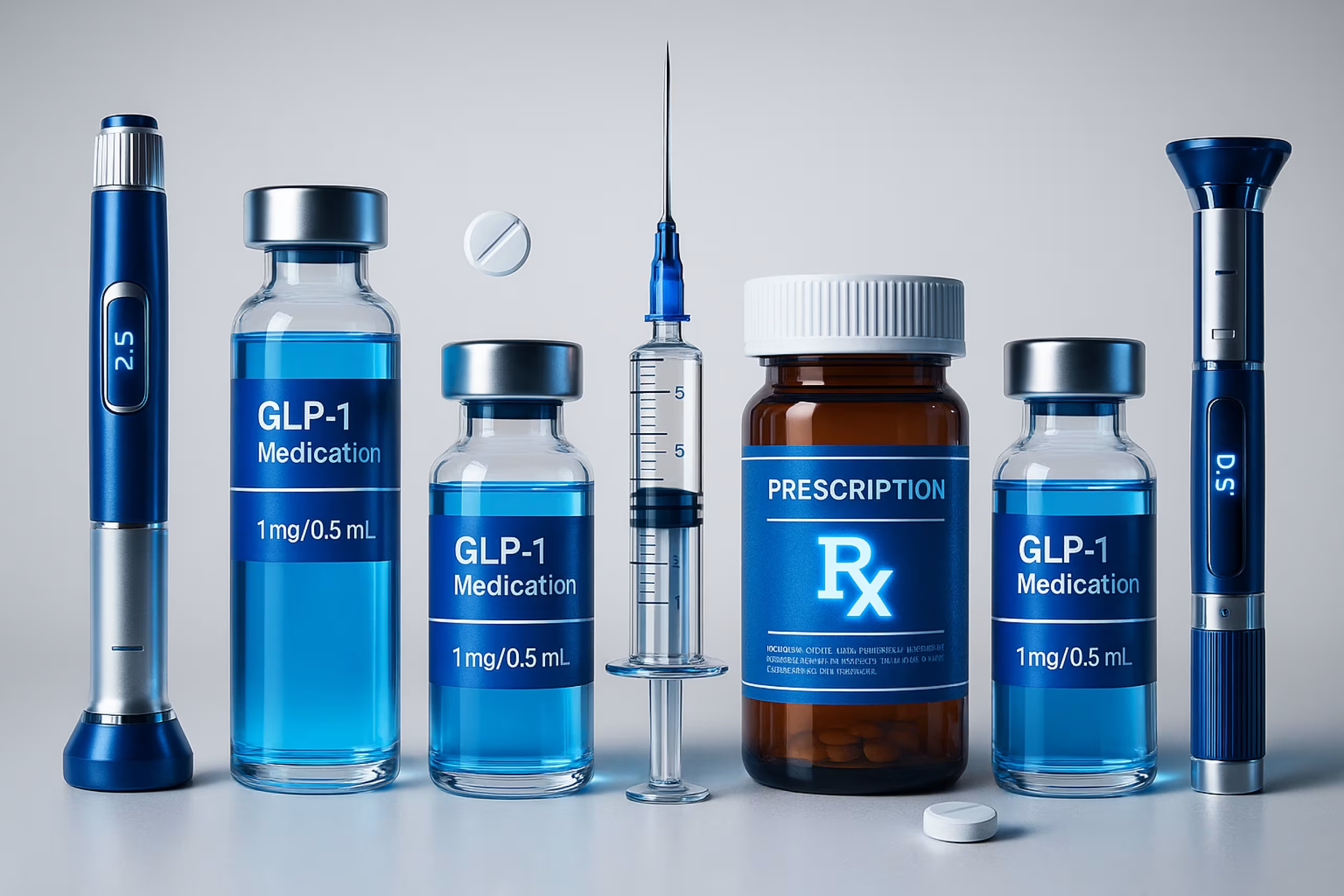

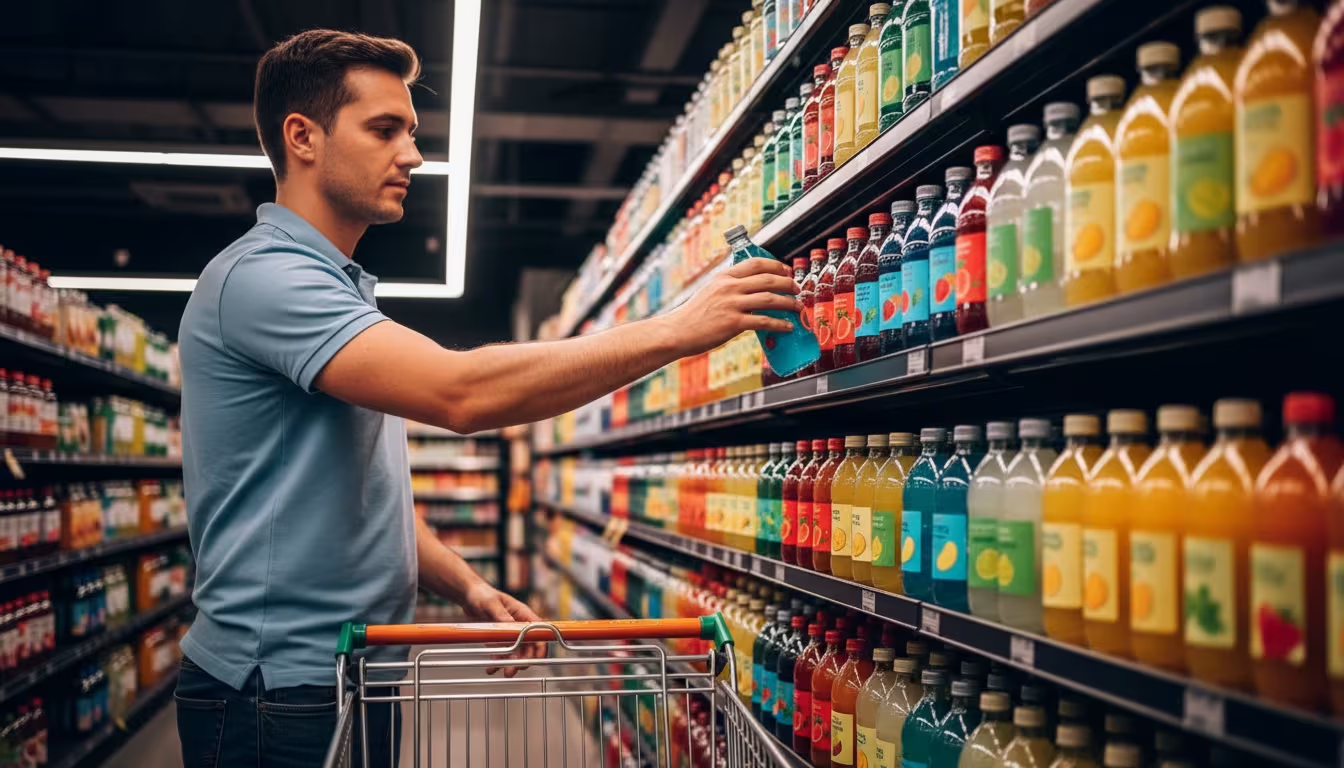



.avif)


